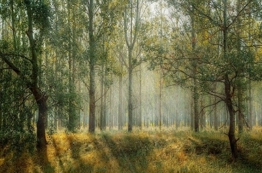Planting and sowing deadlines before the shemitah year

What are the planting and sowing deadlines before shemitah for trees, vegetables, and other plants?
A. Planting trees
Introduction
The Mishnah (Shevi'it 6:2) states that trees should not be planted in the sixth year unless they take root prior to Rosh Hashanah. The Gemara (Rosh Hashanah 10b) adds an additional 30-day requirement. The Rishonim disagree whether this addition is due to (1) tosefet shevi'it,[1] or (2) maryit ayin – so it will not appear that the tree was planted during shemitah. The additional 30 days count as an entire orlah year; otherwise, the tree's first orlah year would be during shemitah.[2]
The practical ramifications of this dispute is the issue of the deadline is for planting fruit trees before shemitah. If the 30-day addition is due to tosefet shevi'it, today tosefet shevi'it does not apply (shemitah being rabbinic). In this case, two weeks before Rosh Hashanah suffice since this is the time trees need to take root.[3]
However, if the reason for the extra 30 days is for the tree's orlah count, we need to plant 44 days before Rosh Hashanah (30 days for the orlah count plus 14 days to take root). Rambam follows the second approach, that 44 days are necessary "lest onlookers say that the tree was planted during the seventh year."[4]
In practice:
Fruit trees
a. Bare-rooted fruit trees – 15 Av.[5]
b. Fruit trees encased in a clod of earth, whose orlah count will restart upon transplant (e.g. sat on a surface detaching it from the ground) – 29 Av.[6]
c. Fruit trees encased in a clod of earth, whose orlah count will continue (e.g. buying a tree from a supervised nursery, moving a tree in the garden from one side to another) – 29 Elul.[7]
Non-fruit trees
For non-fruit trees, there is no issue of appearances, so there is no need for the additional 30-day period for orlah. However, the posekim dispute whether it is possible to forego the 14 days to take root and plant such trees until erev Rosh Hashanah; or if the planting deadline is 15 Elul, since it is forbidden that they take root during shemitah due to the injunction veshavtah ha'aretz (and the land shall rest).[8]
a. Bare-rooted trees – 15 Elul;[9] in extenuating circumstances, 29 Elul.[10]
b. Non-fruit trees encased in a clod of earth – 29 Elul.
B. Planting and sowing various types of plants
Introduction
For plants, similar to non-fruit trees, there is no issue of appearances. However, the Acharonim disagree whether the plants require a three-day period to take root during the sixth year,[11] or if it is sufficient to plant them erev Rosh Hashanah. For many plants, though, the sefichin prohibition applies.[12] For this reason, if annuals take root during shemitah, they will be forbidden to eat. For such plants it is important to ascertain that they take root properly during the sixth year, and a period longer than three days is necessary.
1. Ornamental plants
Ornamental plants should be planted by 26 Elul;[13] when necessary, up to 29 Elul.[14]
2. Vegetables
a. Sowing – Sowing and watering should be completed as early as possible to allow vegetables to sprout before Rosh Hashanah. In this way, the prohibition of sefichin will not apply to the crop.[15]
b. Planting
i. Bare-rooted vegetables should be planted by 26 Elul;14 when necessary, by 29 Elul.15
ii. Vegetables that come in small planters with soil can be planted by 29 Elul.[16]
3. Grains and legumes
Sowing and watering should be completed as early as possible to allow them to sprout before Rosh Hashanah. In this way, the prohibition of sefichin will not apply to the crop.
4. Bulbs
Bulbs can be buried in the ground until 29 Elul.[17]
5. Grass
Lay turf several weeks before shemitah to allow it to take root and to make it possible to mow the lawn once before the onset of shemitah.
[1] Rashi, Rosh Hashanah 10b. When the Beit Hamikdash was standing, there were certain melachot that were prohibited starting 30 days prior to Rosh Hashanah of the shemitah year. This prohibition is a halachah leMoshe miSinai and is called tosefet shevi'it, addition to the seventh year; it is similar to tosefet Shabbat, the additional time period we refrain from performing melachah before Shabbat.
[2] Rabbeinu Tam, qtd. by the Tosafot (Rosh Hashanah 9b, s.v. umutar; ibid., 10b, s.v. sheloshim; Yevamot 83a, s.v. ledivrei); Ritva, Rosh Hashanah 9b; Tosafot Rid, ibid., 7b. For a discussion on the opinion of Rabbeinu Tam, see Rash (Shevi'it 1:1, s.v. od; 2:6, s.v. pachot).
[3] See Shabbat Ha'aretz 3:11, pp. 351–352.
[4] Rambam, Hilchot Shevi'it Veyovel 3:11.
[5] Aruch Hashulchan, Hilchot Shemitah 18:3; HaTorah Vehamedinah IV, p. 137 §a; Betzet Hashanah p. 42 s.v. neti'ah; Rabbi Mordechai Eliahu, Ma'amar Mordechai, Shevi'it 1:3. Note that some maintain that it is permitted to plant through 16 Av, under the principle of miktzat hayom kechulo, (part of the day is like the entire day). See: Meiri (Rosh Hashanah 9b, s.v. acher; Yevamot 83a, s.v. kvar bi'arnu); Rabbeinu Yerucham, Sefer Adam, Netiv 21 II §177a, 2nd column; Sha'agat Aryeh, Dinei Chadash §7; Yeshu'ot Malko, Hilchot Ma'aser Sheni 9:10; Chazon Ish (Shevi'it 17:29; ibid., 21:2; Dinei Orlah §2–3; Teshuvot Veketavim, Zera'im §26); Rabbi Shlomo Zalman Auerbach (Responsa Minchat Shlomo I §51:5; Ma'adanei Eretz, Shevi'it, notes §8:5); Derech Emunah (Hilchot Ma'aser Sheni 9:10 §89; Bi'ur Halachah, ibid., s.v. hanote'a). However, see also Noda Beyehudah (OC §84 s.v. ve'od amina; YD §§87–88), that the miktzat hayom kechulo principle does not apply, rather a full two-week period is necessary, as it seems from the plain reading of the Rambam (Hilchot Shemitah Veyovel 3:11; Hilchot Ma'aser Sheni 9:10–11; Responsa of the Rambam, Blau ed. §338; Tur, YD §294; Shulchan Aruch, ibid., §4; Aruch Hashulchan, YD 294:22. For more on this, see Neta Hilulim, p. 14, Zera Gad §6.
[6] The reason that 14 days is not needed for the tree to take root is the fact that its roots are encased in a clod of earth large enough to nourish gives the tree the status of having taken root.
[7] Rabbi Yitzchak Herzog, Pesakim Veketavim III §47:2, Sefer Hashemitah I 1:3; HaTorah Vehamedinah, ibid. (see n. 5 above); Betzet Hashanah, p. 42; Rabbi Binyamin Yehoshua Zilber, Hilchot Shevi'it §2, Kisse David §70; Shabbat Ha'aretz 3:11b, p. 353.
[8] See Minchat Chinuch, end of mitzvah 326. This question depends on the definition of veshavtah ha'aretz, namely, if it is a personal obligation (i.e. that people should avoid working the land), or if the prohibition relates to the land (i.e. that the land should not be worked). If the prohibition relates to people, as long as no act is actively performed during the shemitah year, it would be permissible. However, if we are obligated to ensure that the land rests, if a forbidden melachah takes place during shemitah, the land is not resting.
[9] Tosafot Rid (Rosh Hashanah 7b, s.v. ve'amar; Mo'ed Katan 3b, s.v. eser; Ri Korkus, Hilchot Shevi'it Veyovel 3:11; Torat Ha'aretz I 6:11–14; Rabbi Tzvi Pesach Frank (Responsa Har Tzvi, OC I §129, end of §209; Zera'im I §37:2); Rabbi Shlomo Zalman Auerbach (Minchat Shlomo I §§48, 51:4; Tanina 2 –3 §123:7); Sefer Hashemitah I 1:2, s.v. vektzat; HaTorah VeHamedinah, ibid., §a; Rabbi Yitzchak Herzog, ibid., §47:1; Betzet Hashanah, ibid.; Kerem Tzion, Shevi'it, Hilchot Shevi'it 1:8. Note the opinion of Rabbi Mordechai Eliahu, Ma'amar Mordechai, Shevi'it 1:4, that non-fruit trees should be planted by 15 Av. Similarly, Rabbi Ben-Tzion Uziel discusses this in HaTorah Vehamedinah IV, p. 140, but does not issue a decisive ruling on the matter. See note 10 below.
[10] Chazon Ish (Shevi'it 22:5, 25:13); Rabbi Shaul Yisraeli, Chavot Binyamin I §9, p. 67; Betzet Hashanah (p. 28, n. 3; p. 42, s.v. netiyah); Rabbi Ben-Tzion Uziel, ibid.
[11] The posekim dispute the amount of time it takes for seeds to take root. Some hold this period is three days only, see: Responsa Terumat Hadeshen §191 (qtd. also by Shach, YD §293:2); Responsa Mishkenot Ya'akov, YD §293:9. Others maintain that this period is 14 days, just like trees. See: Shach, Nekudot Hakesef, YD §293:1; Gra, ibid., §2; Rabbi Akiva Eiger, ibid., §3; Rabbi Yechezkel Landau (Dagul Mirvavah, YD §293; Responsa Noda Beyehudah, OC §84). For more on this topic, see: Responsa Chatam Sofer (YD §§284, 286), who equates the time to take root for seeds to take root to the time it takes trees to take root, but does not distinguish between dinei Torah lechumrah and dinei Derabanan.
[12] This prohibition is a rabbinic decree, prohibiting eating annual plants that sprout during the shemitah year to prevent people from clandestinely planting and claiming that the plants sprouted on their own.
[13] Following the opinion that it is forbidden for the plant to take root during the shemitah year; see n. 9 above. See also Chazon Ish, Teshuvot Veketavim, Zera'im §26.
[14] Following the opinion that it is not forbidden for the plant to take root during the shemitah year; see n. 10 above.
[15] Chazon Ish, Shevi'it §22:2.
[16] Yehoshua Moshe Aharonson (Yeshuat Moshe I§2; Inyanei Shevi'it §2).
[17] Kerem Tziyon, Shevi'it, Hilchot Shevi'it 1, Gidulei Tzion §10; Ma'amar Mordechai, Shevi'it 1:7.




